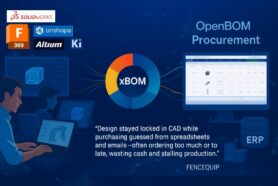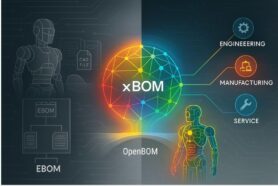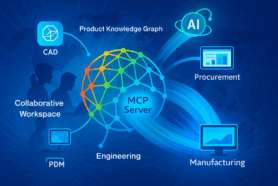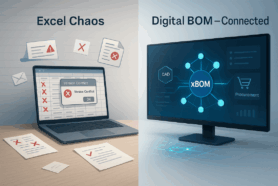
In today’s fast-paced and competitive manufacturing business landscape, companies are still facing the same old goals – cheaper, better, faster. How to deliver these goals remains a big question to all engineering and manufacturing leaders. The timeline for new product development is shortened and the complexity of products is growing. This brings companies to the question of how to adopt modern digital tools to lead digital transformation. Digital transformation is not a buzzword anymore. Organizations are finding digital transformation as a way to change the way they are doing business in this modern digital environment.
While the amount of technological vendors is growing every day, companies are looking at how to find the right technologies and create a strategy to adopt these technologies in their manufacturing and business processes.
To truly outcompete in the digital age, companies must go beyond mere adoption and instead undertake a fundamental rewiring of their organizational structure and processes including managing raw materials, manufacturing process, and supply chain management. This rewiring enables them to extract maximum value from digital transformation initiatives, introducing new technologies to product lifecycle management, to bringing product data management to digitally transform the product development process and production process.
Embracing a Digital Mindset
The first step in rewiring an organization for digital success is to bring a digital mindset. It starts from the communication of a clear vision but ends up with the formulation of a clear technological and strategic position of digital transformation. As such, companies need to re-think the way companies look at their data and process organization’s ability. For many engineering organizations, the data is an afterthought, the outcome of their activities. Releasing documents (drawings) and storing them in folders and files in a way that won’t allow easy access is one example. Creating Excel reports and duplicating records for the same component without the ability to make impact analyses and assessments about how this component is used can be another example. A digital mindset is a cultural change that companies put on themselves, but it goes down very granularly as a new technology and mechanism to manage and leverage information in the organization.
Company leaders must communicate a clear vision for digital transformation and empower employees to experiment, fail fast, and learn from mistakes. Which always starts from the alignment between strategy and technology plays.
Aligning Strategy with Technology
Technology itself cannot solve the problem. Companies should start with a deep understanding of modern digital technologies. One of the challenges is that companies lack education about what modern technology can do and instead of evaluating it, try to figure out how to use new technologies to implement old patterns of processes. Modern technologies such as the OpenBOM platform can help you to experiment without introducing a disruption in your organization. A modern platform, which includes the capabilities to start fast and adjust, this is the biggest leverage for organizations looking at how to transform.
While the business strategy and processes often need to lead, the ability to create a trial OpenBOM account and start experimenting with the technology, capturing testing data, applying some organizational data logic, and creating a new digital process model is extremely important, because it happens without isolation and by providing a real working environment to experiment and learn.
Register an OpenBOM account and start experimenting now. Digital transformation cannot exist in isolation from business strategy. But having technology in your hands can help to align closely with organizational goals and objectives. By integrating technology into every facet of the business strategy, companies can leverage digital capabilities to drive growth, enhance customer experiences, and optimize operations.
Agile and Adaptive Structures
Data siloes are the biggest challenges in every engineering and manufacturing organization. Traditional hierarchical structures close agility and innovation preventing people from setting up an environment that improves communication and data management. As such OpenBOM offers an agile new product development framework and process.
Rewiring organizations involves adopting flatter, more agile structures that empower cross-functional teams to collaborate seamlessly. OpenBOM allows you to combine data and help companies and teams go from design information to bill of materials (BOM) and then to production planning, procurement, and orders.
OpenBOM’s patented real-time collaboration methods support agile methodologies similar to scrum or kanban enabling rapid iteration and adaptation, ensuring that the organization can respond quickly to changing product design, supply chain, and customer needs.
Data-Driven Decision Making
Data is the lifeblood of digital transformation. Rewired organizations prioritize data collection, analysis, and utilization to drive informed decision-making. A digital product knowledge graph is a data foundation of OpenBOM, which allows a data foundation for decision-making. An example of such a process is an impact analysis allowing companies to navigate through complex data sets, unlocking opportunities for improvements. An example of a recent Impact Analysis tool allows an easy way to organize data and perform queries.
Customer-Centricity and User Experience
In the digital era, customer expectations are higher than ever before. Rewired organizations place a premium on customer-centricity, using technology to deliver personalized experiences across all organizational silos. OpenBOM is strategically focusing on user experience to help companies to drive the adoption of digital tools. Here are two examples of how OpenBOM helps you to focus on customer needs:
- Streamlined data capturing from multiple engineering tools. Check this article and learn how a company can seamlessly capture data to build a digital product model.
- At the same time, intuitive UI and UX are the foundations of OpenBOM adoption. Customers can see a very familiar spreadsheet-like user experience.
From intuitive user interfaces to predictive analytics, every interaction is tailored to meet the unique needs and preferences of the customer. Take a look at the recent sort and filter user experience.
Continuous Learning and Development
Digital transformation is an ongoing journey, not a destination. Rewired organizations foster a culture of continuous learning and development to keep pace with rapid technological advancements. From up-skilling employees and helping them to learn new tech to empowering the employees and switching to modern tools and leaving the analog techniques in the past.
Collaboration and Ecosystem Partnerships
No organization can thrive in isolation. Rewiring involves forging strategic partnerships and collaborations within the broader ecosystem. Whether it’s partnering with startups for innovation or collaborating with industry peers on shared challenges, organizations can leverage collective expertise and resources to drive mutual success.
At OpenBOM, we take partnerships very seriously. It starts from the broad commitment of OpenBOM not to block customers from sharing data and communicating, but it ends with the ability to learn and optimize existing systems and tools gradually.
Conclusion
In the digital age, the ability to outcompete is not limited to technology, but to alignment between technological future and organizational changes. It is not just on technology adoption but on the fundamental rewiring of organizational structures and processes. By embracing a digital mindset, aligning strategy with technology, bringing agility, prioritizing data-driven decision-making, and placing customers and data at the center of everything they do, organizations can unlock the full potential of digital transformation. With continuous learning, collaboration, and a relentless focus on innovation, they can position themselves as leaders in their respective industries, ready to thrive in an ever-evolving landscape.
REGISTER FOR FREE and check out how you can introduce OpenBOM to support your digital transformation.
Best, Oleg
Join our newsletter to receive a weekly portion of news, articles, and tips about OpenBOM and our community.










